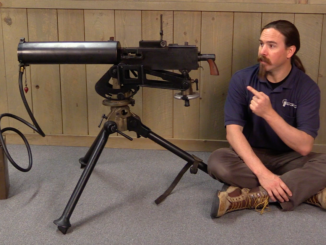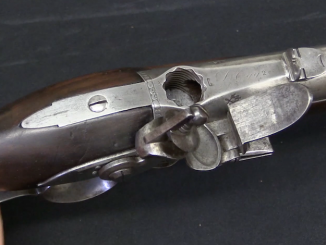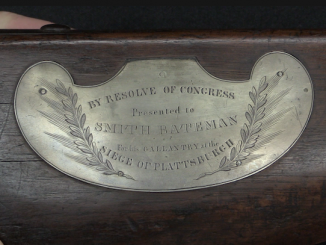Our final quick video from RIA this weekend is a look at a sporterized M1 Carbine – but one that was actually done quite nicely! I would never suggest that someone cut up an intact collectible firearm to do something like this, but once it’s already done there is no reason to automatically dismiss it. While most sporterization is cringe-worthy at best, this particular M1 Carbine is an example of how it can be done well. Everyone who picked it up found themselves really liking it…
Related Articles

Heavy MGs
Browning M1917: America’s World War One Heavy Machine Gun
When the United States entered World War One, its military has a relatively tiny handful of machine guns, and they were divided between four different types, as the military budget was small and machine guns […]

Flintlock
Durs Egg Ferguson – A Trials Breechloader From 1776
This Ferguson rifle sold for $96,000. Captain Patrick Ferguson was a British officer who designed and patented a breechloading rifle in 1776, which would actually see service in the American Revolution at the Battle of […]

Antiques
Teenagers vs the British Empire: Smith Bateman’s Hall Rifle
On May 20, 1826 the United States Congress formally presented Model 1819 Hall rifles with personalized silver plaques to the 20 members of Aikin’s Volunteers, for their “Gallantry at the Siege of Plattsburg”. The Volunteers […]

I have seen this type of M1 Carbine before. The word I got on it was it was sporterized after the Korean War by a reputable gunsmith. Some were NOT M1’s but M2’s, the one that I saw was an M2 although the owner didnot know it.
The deflector is to keep empty cases from hitting a scope and damaging it.
I have a soft cover book, dated 1969, put out by the Williams Gun Sight Company. The title is “HOW TO CONVERT MILITARY RIFLES”. It shows many popular military rifles being ‘sporterized’. The carbine conversions look a lot like the carbine shown in today’s video. Prices are given for the different parts, stocks, and such and who they come from. It looks like Williams would do the whole job for you or sell you some parts and you could order stocks and such from other people and try your hand at it.
Oh yeah. Have seen lots of collectible pieces ruined. I remember a “Guns” magazine article on how to sporterize your German G 33/40 carbine by cutting the stock back and using a propane torch to make a spiral pattern on the wood. Concerning M1 Carbines, the Higbee Dept Store in downtown Cleveland, Ohio had a gun shop in the early Sixties that was selling M1 Carbines in 55 gallon drum. It was only after they had all been sold that ATF showed up. It seems this b batch had all been the full-auto M2 version that had been surpluses by mistake. Times being what they were, there was no paperwork other than copies of sales receipts with no names. They’re out there somewhere.
Reminds me of this for some reason
http://www.imfdb.org/wiki/Planet_of_the_Apes_(1968)
The feature I find most useful is the extended forestock, protecting the rather exposed barrel the M-1 has.
Sporterizing M1 Carbines was a popular thing in gun magazines in the early 1960s. Mannlicher stocks were often a feature of the conversions.
As for telescopic sights, most used an offset side mount to keep the scope away from the straight-up ejection path of the Carbine action. Most “case deflectors” tended to deflect the case straight back down into the boltway.
One feature of these conversions was a modified magazine, cut off flush with the bottom of the magazine catch block and holding only five rounds. This was to adhere to several states’ hunting regulations permitting only five rounds or less capacity. Of course, most such states didn’t allow the .30 USC round to be used for hunting, either.
Keep in mind that at the time, M1 Carbines were not considered particularly “collectible”, and that they were available most places for under $50, as were most surplus rifles, pistols, and etc.
To get some idea of what it was like, take modern-day new-item MSRPs and divide by 10.
Divide typical modern auction prices by 100.
cheers
eon
“Of course, most such states didn’t allow the .30 USC round to be used for hunting, either.”(C)
This is what I wanted to ask from the very beginning.
And who can be hunted with this “human” cartridge?
IMHO Only pests in the backyard.
And 22LR is better for this …
Out west, the .30 USC was a popular round for coyote hunters, because it was cheap and with a decent scope of about 4X the carbine was accurate to about 150 yards.
In the south, the carbine was considered a good weapon against obstreperous alligators, as it had enough penetration to get inside the skull of same and smack its brain good and hard.
During the Pacific Campaign, it was found to be an efficient shark killer, again due to its penetrative characteristics.
It is not legal for deer in most states. But since many of those same states allow .357 Magnum revolvers as long as they have at least 6″ barrels to achieve maximum velocity, you have to wonder.
Is a 158-grain .357″ JSP at 1,450 F/S (740 FPE)really a better “deer-dropper” than a 110-grain .308″ JSP at 1,850 (840 FPE)?
cheers
eon
Inland should make a run of these.
That is, the only excuse is the cost of military surplus…
From my experience I know that the action on an object the size of a dog, 22LR cartridges and 7.63 Mauser (or 7.62×25), is almost the same.
The only advantage of 7.63 is a flatter trajectory.
I heard about an effective .30car distance of 150 meters from my friend, who was trying to use a military carbine with optics as the Marksman-weapon.
Theoretically, a bullet has enough energy and accuracy twice as far, but in practice (due to a bullet falling) without an accurate determination of the distance, hitting into something less than a telephone booth can be done only by chance…
Back in the 60’s, my Dad bought me a surplus M1 Carbine from the DCM (Department of Civilian Marksmanship) for $35.00. I subscribed to “Gun World” or was it “GUNS” magazine which ran a 3 part article that showed how to sporterize the carbine. I was 14 years old at the time and did a complete overhaul of the gun filing off the milling marks, new sights from Williams Gunsight Co., bluing and I used a thumb hole Mannlicher-Schoenauer stock finished with eight coats of linspeed oil. The gun came out exactly as per the magazine article and to this day looks beautiful. I live in Ct. and unfortunately due to the state assault weapons ban, my M1 Carbine is considered an assault weapon because it has a thumb hole stock. So I picked up a cheap surplus stock and will finish it and transfer the gun to the new stock so I can legally shoot it without risking confiscation.